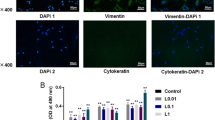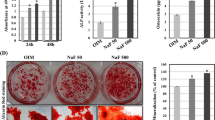Abstract
Human periodontal ligament cells (hPDLCs) and human alveolar osteoblasts (hAOBs) play pivotal roles in periodontium. The regulatory effects of epigallocatechin gallate (EGCG) on hPDLCs and hAOBs remained unclear. This study probed into the functions of EGCG treating periodontal diseases. Cultured hAOBs and hPDLCs were passaged and observed by microscopic examination, and alkaline phosphatase (ALP) and immumohistochemical staining were performed for verification. hAOBs and hPDLCs were treated with EGCG and LY294002 + EGCG, then the proliferation of the two cells was assayed by MTT. Mineralization of the treated hAOBs and hPDLCs was detected by ALP activity experiment and Alizarin Red S staining kit. Quantitative real-time polymerase chain reaction (qRT-PCR) and Western blotting were performed for the detection of the expressions of differentiation-related mRNAs and PI3K/Akt signaling pathway-related proteins in the two cells. The third passage of hAOBs mainly showed triangle shape and were positive by ALP staining. hPDLCs in passage 3 adhered to the wall in spiral or radial pattern with positively stained vimentin and negatively stained keratin. Cell proliferation and ALP activity of the hAOBs and hPDLCs were increased by EGCG treatment. The mineralized nodules and expressions of differentiation-related mRNAs, the phosphorylation of PI3K and Akt of the hAOBs and hPDLCs were promoted by EGCG treatment, while the effects of LY294002 treatment were opposite to EGCG treatment. Epigallocatechin gallate affected the proliferation and differentiation of hAOBs and hPDLCs through regulating PI3K/Akt signaling pathway.





Similar content being viewed by others
References
Barczyk M, Bolstad AI, Gullberg D. Role of integrins in the periodontal ligament: organizers and facilitators. Periodontol 2000. 2013;63(1):29–47. https://doi.org/10.1111/prd.12027.
McCulloch CA, Lekic P, McKee MD. Role of physical forces in regulating the form and function of the periodontal ligament. Periodontology. 2000;2000(24):56–72.
McCulloch CA, Melcher AH. Cell density and cell generation in the periodontal ligament of mice. Am J Anat. 1983;167(1):43–58. https://doi.org/10.1002/aja.1001670105.
Isaka J, Ohazama A, Kobayashi M, Nagashima C, Takiguchi T, Kawasaki H, et al. Participation of periodontal ligament cells with regeneration of alveolar bone. J Periodontol. 2001;72(3):314–23. https://doi.org/10.1902/jop.2001.72.3.314.
McCulloch CA. Progenitor cell populations in the periodontal ligament of mice. Anat Rec. 1985;211(3):258–62. https://doi.org/10.1002/ar.1092110305.
McCulloch CA, Nemeth E, Lowenberg B, Melcher AH. Paravascular cells in endosteal spaces of alveolar bone contribute to periodontal ligament cell populations. Anat Rec. 1987;219(3):233–42. https://doi.org/10.1002/ar.1092190304.
Seo BM, Miura M, Gronthos S, Bartold PM, Batouli S, Brahim J, et al. Investigation of multipotent postnatal stem cells from human periodontal ligament. Lancet (London, England). 2004;364(9429):149–55. https://doi.org/10.1016/s0140-6736(04)16627-0.
Arceo N, Sauk JJ, Moehring J, Foster RA, Somerman MJ. Human periodontal cells initiate mineral-like nodules in vitro. J Periodontol. 1991;62(8):499–503. https://doi.org/10.1902/jop.1991.62.8.499.
Jonsson D, Nebel D, Bratthall G, Nilsson BO. The human periodontal ligament cell: a fibroblast-like cell acting as an immune cell. J Periodontal Res. 2011;46(2):153–7. https://doi.org/10.1111/j.1600-0765.2010.01331.x.
Nagata M, Iwasaki K, Akazawa K, Komaki M, Yokoyama N, Izumi Y, et al. Conditioned medium from periodontal ligament stem cells enhances periodontal regeneration. Tissue Eng Part A. 2017;23(9–10):367–77. https://doi.org/10.1089/ten.TEA.2016.0274.
Niemiec BA. Periodontal disease. Topics Companion Anim Med. 2008;23(2):72–80. https://doi.org/10.1053/j.tcam.2008.02.003.
Lee JS, Lee JB, Cha JK, Choi EY, Park SY, Cho KS, et al. Chemokine in inflamed periodontal tissues activates healthy periodontal-ligament stem cell migration. J Clin Periodontol. 2017;44(5):530–9. https://doi.org/10.1111/jcpe.12710.
Wang J, Xie Y, Feng Y, Zhang L, Huang X, Shen X, et al. (-)-Epigallocatechingallate induces apoptosis in B lymphoma cells via caspase-dependent pathway and Bcl-2 family protein modulation. Int J Oncol. 2015;46(4):1507–15. https://doi.org/10.3892/ijo.2015.2869.
Yang CS, Wang H. Cancer preventive activities of tea catechins. Molecules (Basel, Switzerland). 2016;21(12):1679. https://doi.org/10.3390/molecules21121679.
Jang JY, Lee JK, Jeon YK, Kim CW. Exosome derived from epigallocatechin gallate treated breast cancer cells suppresses tumor growth by inhibiting tumor-associated macrophage infiltration and M2 polarization. BMC Cancer. 2013;13:421. https://doi.org/10.1186/1471-2407-13-421.
Yun JH, Kim CS, Cho KS, Chai JK, Kim CK, Choi SH. (-)-Epigallocatechin gallate induces apoptosis, via caspase activation, in osteoclasts differentiated from RAW 264.7 cells. J Periodontal Res. 2007;42(3):212–8. https://doi.org/10.1111/j.1600-0765.2006.00935.x.
Vali B, Rao LG, El-Sohemy A. Epigallocatechin-3-gallate increases the formation of mineralized bone nodules by human osteoblast-like cells. J Nutr Biochem. 2007;18(5):341–7. https://doi.org/10.1016/j.jnutbio.2006.06.005.
Tepedelen BE, Soya E, Korkmaz M. Epigallocatechin-3-gallate reduces the proliferation of benign prostatic hyperplasia cells via regulation of focal adhesions. Life Sci. 2017;191:74–81. https://doi.org/10.1016/j.lfs.2017.10.016.
Pilloni A, Pompa G, Saccucci M, Di Carlo G, Rimondini L, Brama M, et al. Analysis of human alveolar osteoblast behavior on a nano-hydroxyapatite substrate: an in vitro study. BMC Oral Health. 2014;14:22. https://doi.org/10.1186/1472-6831-14-22.
Coates DE, Zafar S, Milne TJ. Quantitative Real-Time Gene Profiling of Human Alveolar Osteoblasts. Methods Mol Biol (Clifton, NJ). 2017;1537:447–59. https://doi.org/10.1007/978-1-4939-6685-1_27.
Iacopino AM, Cutler CW. Pathophysiological relationships between periodontitis and systemic disease: recent concepts involving serum lipids. J Periodontol. 2000;71(8):1375–84. https://doi.org/10.1902/jop.2000.71.8.1375.
Polimeni G, Xiropaidis AV, Wikesjo UM. Biology and principles of periodontal wound healing/regeneration. Periodontology. 2000;2006(41):30–47. https://doi.org/10.1111/j.1600-0757.2006.00157.x.
Cho MI, Garant PR. Development and general structure of the periodontium. Periodontology. 2000;2000(24):9–27.
Gronthos S, Mankani M, Brahim J, Robey PG, Shi S. Postnatal human dental pulp stem cells (DPSCs) in vitro and in vivo. Proc Natl Acad Sci USA. 2000;97(25):13625–30. https://doi.org/10.1073/pnas.240309797.
Nagatomo K, Komaki M, Sekiya I, Sakaguchi Y, Noguchi K, Oda S, et al. Stem cell properties of human periodontal ligament cells. J Periodontal Res. 2006;41(4):303–10. https://doi.org/10.1111/j.1600-0765.2006.00870.x.
Monje A, Chan HL, Galindo-Moreno P, Elnayef B, Suarez-Lopez del Amo F, Wang F, et al. Alveolar bone architecture a systematic review and meta-analysis. J Periodontol. 2015;86(11):1231–48. https://doi.org/10.1902/jop.2015.150263.
Jung IH, Lee DE, Yun JH, Cho AR, Kim CS, You YJ, et al. Anti-inflammatory effect of (-)-epigallocatechin-3-gallate on Porphyromonas gingivalis lipopolysaccharide-stimulated fibroblasts and stem cells derived from human periodontal ligament. J Periodontal implant Sci. 2012;42(6):185–95. https://doi.org/10.5051/jpis.2012.42.6.185.
Tian B, Sun Z, Xu Z, Hua Y. Chemiluminescence analysis of the prooxidant and antioxidant effects of epigallocatechin-3-gallate. Asia Pac J Clin Nutr. 2007;16(Suppl 1):153–7.
van Straalen JP, Sanders E, Prummel MF, Sanders GT. Bone-alkaline phosphatase as indicator of bone formation. Clin Chim Acta Int J Clin Chem. 1991;201(1–2):27–33. https://doi.org/10.1016/0009-8981(91)90021-4.
Sartori EM, Magro-Filho O, Silveira Mendonca DB, Li X, Fu J, Mendonca G. Modulation of micro RNA expression and osteoblast differentiation by nanotopography. Int J Oral Maxillofac Implant. 2018;33(2):269–80. https://doi.org/10.11607/jomi.5372.
Yu JS, Cui W. Proliferation, survival and metabolism: the role of PI3K/AKT/mTOR signalling in pluripotency and cell fate determination. Development (Cambridge, England). 2016;143(17):3050–60. https://doi.org/10.1242/dev.137075.
Yi T, Lee HL, Cha JH, Ko SI, Kim HJ, Shin HI, et al. Epidermal growth factor receptor regulates osteoclast differentiation and survival through cross-talking with RANK signaling. J Cell Physiol. 2008;217(2):409–22. https://doi.org/10.1002/jcp.21511.
Luo KW, Lung WY, Chun X, Luo XL, Huang WR. EGCG inhibited bladder cancer T24 and 5637 cell proliferation and migration via PI3K/AKT pathway. Oncotarget. 2018;9(15):12261–72. https://doi.org/10.18632/oncotarget.24301.
Funding
This study was supported by grants from Project of Health and Science in Zhejiang (Grant No. 2016KYB233 & 2019KY497).
Author information
Authors and Affiliations
Contributions
Substantial contributions to conception and design: CD, SF. Data acquisition, data analysis and interpretation: XC, CC, HW, LZ. Drafting the article or critically revising it for important intellectual content: CD, SF. Final approval of the version to be published: all authors. Agreement to be accountable for all aspects of the work in ensuring that questions related to the accuracy or integrity of the work are appropriately investigated and resolved: all authors.
Corresponding authors
Ethics declarations
Conflicts of interest
The authors declare no conflict of interest.
Research involving human participants and/or animals
All procedures performed in studies involving human participants were in accordance with the ethical standards of the institutional and/or national research committee and with the 1964 Helsinki Declaration and its later amendments or comparable ethical standards. The clinical trial program had been reviewed and approved by the Ethics Committee of the Affiliated Hospital of Hangzhou Normal University (AH2017030821).
Additional information
Publisher's Note
Springer Nature remains neutral with regard to jurisdictional claims in published maps and institutional affiliations.
Rights and permissions
About this article
Cite this article
Ding, C., Fu, S., Chen, X. et al. Epigallocatechin gallate affects the proliferation of human alveolar osteoblasts and periodontal ligament cells, as well as promoting cell differentiation by regulating PI3K/Akt signaling pathway. Odontology 109, 729–740 (2021). https://doi.org/10.1007/s10266-021-00597-1
Received:
Accepted:
Published:
Issue Date:
DOI: https://doi.org/10.1007/s10266-021-00597-1




